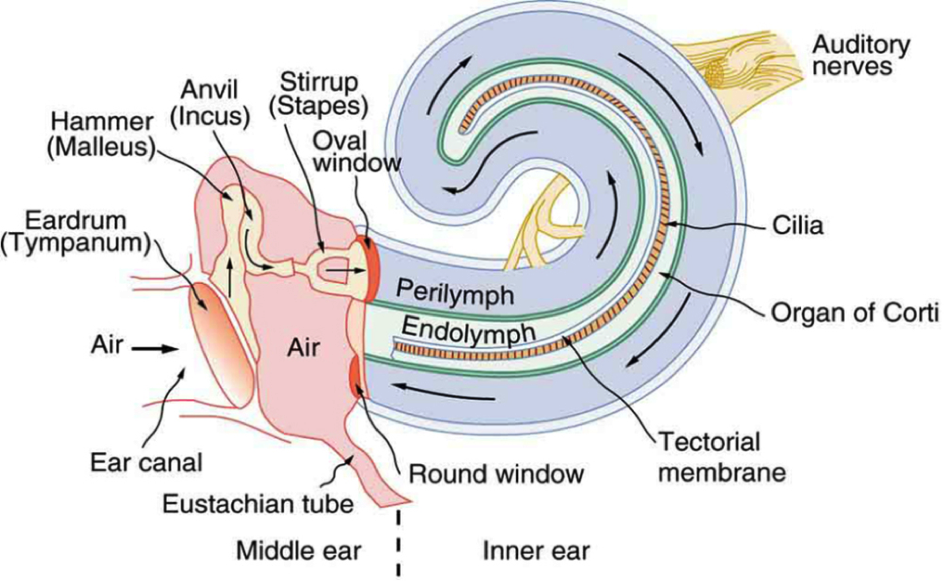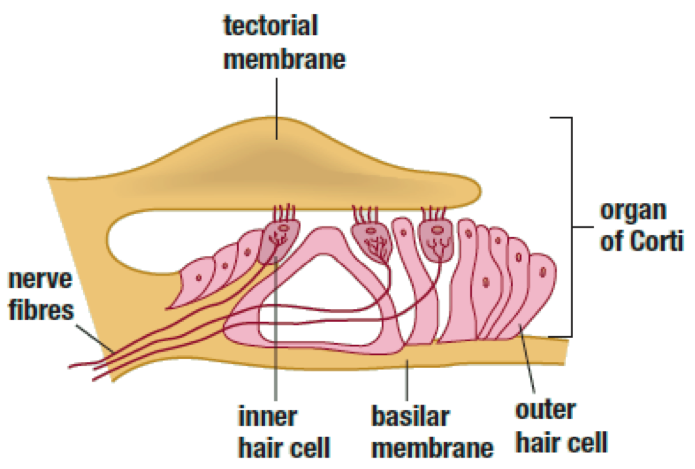SOUND AND HEARING
Sound is a mechanical wave of frequencies within the human audible range. Generally, a mechanical wave is an oscillation that travels through space, accompanied by a transfer of energy. Mechanical waves propagate through a medium, and the substance of this medium is deformed. The deformation reverses itself owing to restoring forces resulting from its deformation. For example, sound waves propagate via air molecules colliding with their neighbours and when air molecules collide, they also bounce away from each other (a restoring force). This keeps the molecules from continuing to travel in the direction of the wave. Therefore wave motion transfers energy from one point to another with no associated mass transport.
Mechanical waves require a medium for the transfer of energy to occur (solid, liquid or gas) and do not propagate in vacuum. There are two basic types of wave motion for mechanical waves: transverse and longitudinal. In case of transverse waves the particle displacement is perpendicular to the direction of wave propagation (an example can be a wave along a string). Transverse waves can occur only in solids phase (and also on the surface of liquids). Because sound typically propagates in air (or more generally in fluids) transverse wave is not so important as the other kind of wave – the longitudinal wave. For longitudinal wave is characteristic that the particle displacement is parallel to the direction of wave propagation. The particles do not move with the wave - they simply oscillate back and forth about their individual equilibrium positions. Longitudinal waves can travel in all phases - solids, fluids as well as gases (i.e. sound propagates through air as a longitudinal wave).
SPEED OF PROPAGATION (SPEED OF SOUND)[edit | edit source]
The speed of wave propagation is almost independent on factors like the frequency or amplitude of the sound but depends on the medium (e.g. air, water) and its conditions like temperature or pressure. Generally, the slowest speed of sound is in gases, faster is in liquids and fastest in solids. For example, the speed of sound in air (at 0°C) is 332 m/s, in air (at 20°C) is 344 m/s, in water is ~1500 m/s, in soft tissues of human body is ~1500 m/s, in ice is ~3200 m/s, in bones ~3700 m/s and in steel ~5000 m/s. In the air (under the normal atmospheric pressure of 101.3kPa) the speed of sound is increasing with increasing temperature t [°C] approximately in a linear way:
v = 331.5 + 0.61∙t [m/s].
ACOUSTIC IMPEDANCE[edit | edit source]
Acoustic impedance Z (or sound impedance) is the ratio of sound pressure to particle velocity (also it is the product of the density of medium and the speed of sound). Acoustic impedance is a very important factor in the determination of acoustic transmission and reflection at the boundary of two materials having different acoustic impedances (the difference in Z is commonly referred to as the impedance mismatch). Sound waves are partially reflected and partially transmitted at boundaries if there is a difference in acoustic impedances (Z) of the materials on each side of the boundary. The greater the impedance mismatch, the greater the percentage of energy that will be reflected at the interface or boundary between one medium and another and the less amount of energy will be transmitted (e.g. on the boundary air/water the amplitude of the reflected wave will be about 99.95% of the incident wave). Acoustic impedance is also important in the assessing absorption of sound in a medium. Absorption is a property of any material that changes the acoustic energy of propagating sound waves into another form of energy (often heat) what results in gradual attenuation of the propagating wave.
Frequency and wavelength Frequency refers to how often (how many times in a unit of time) the vibration repeats and it is expressed in Hz (hertz). The frequency is determined by the source of the wave (e.g. speaker, string). The most simple case of vibration is harmonic one: y(t)=A∙sin (2π∙f∙t + φ0), where A is the amplitude, f frequency, t time and φ0 refers to the initial phase. Three types of mechanical waves are distinguished according to the wave frequency: Infrasound of frequencies < 20 Hz, audible sound (i.e. sound that is perceptible by humans) of the range 20 Hz –20 kHz and ultrasound with frequencies > 20 kHz. The term "ultrasonic" applied to sound refers to anything above the frequencies of audible sound, and nominally includes anything over 20,000 Hz. Frequencies used for medical diagnostic ultrasound scans extend to 10 MHz and beyond. The wavelength is the distance between consecutive points of the same phase (i.e. the distance over which the wave's shape repeats). Wavelength is determined by the frequency and the speed of sound: λ = v / f.
Assuming a constant speed of propagation, the wavelength is inversely proportional to frequency: waves with higher frequencies have shorter wavelengths, and lower frequencies have longer wavelengths.
An auditory sensation of a frequency is commonly referred to as the pitch of a sound. Pitch is a distinctive quality of a sound, which dependent primarily on the frequency of the sound waves produced by its source; pitches are compared as "higher" and "lower". Pitch is closely related to frequency, but the two are not equivalent. Frequency is an objective (scientific) concept, whereas pitch is subjective. Sound waves themselves do not have a pitch, and their oscillations can be measured to obtain a frequency. It takes a human brain to map the internal quality of a pitch. Timbre (also referred as tone colour or tone quality), is the quality of a sound (typically musical tones and voices) that distinguishes different types of sound production. The physical characteristic of sound that determines the perception of timbre is mainly its frequency spectrum. For instance, it is the difference between a guitar and a piano playing the same note at the same loudness.
SOUND INTENSITY AND ACOUSTIC PRESSURE[edit | edit source]
The strength of the sound is quantified by sound intensity and sound pressure. Sound intensity (or acoustic intensity, I) is defined as the sound power per unit area, while sound pressure (or acoustic pressure, p) is the local pressure deviation from the ambient (equilibrium) atmospheric pressure, caused by a sound wave. Sound intensity is not the same physical quantity as sound pressure, but they are related each other. Sound pressure can be easily measured using a microphone. As expressed by the Weber’s and Fechner's laws subjective sensation of sound intensity is proportional to the logarithm of the stimulus intensity. Therefore logarithmic quantities are widely used in acoustics. The Sound Pressure Level (SPL) is a logarithmic scale of sound pressure (p) defined relative to a reference sound pressure that is approximately the sound pressure of a 1000 Hz sinusoid that is just barely audible; its unit is dB (decibel): L = 20 log (p/p0), where p0 = 2 x 10-5 Pa. A similar logarithmic scale can be applied also on the sound intensity (relative to a reference sound intensity that is approximately the sound intensity of a 1000 Hz sinusoid that is just barely audible) intensity level value can be calculated: L = 10 log (I/I0), where I0 = 10-12 W/m2. For clinical purpose, the sound intensity is typically measured not in dB SPL, but rather in dB HL (decibels Hearing Level), i.e. dB relative to the quietest sounds that a young healthy individual ought to be able to hear. It means that the resulting audiogram in dB HL shows deviation from what is regarded as 'normal' hearing. Thresholds bellow +20 dB HL are considered in the normal range, while thresholds above 20 dB HL are reported as the hearing loss (mild, moderate, severe or profound).
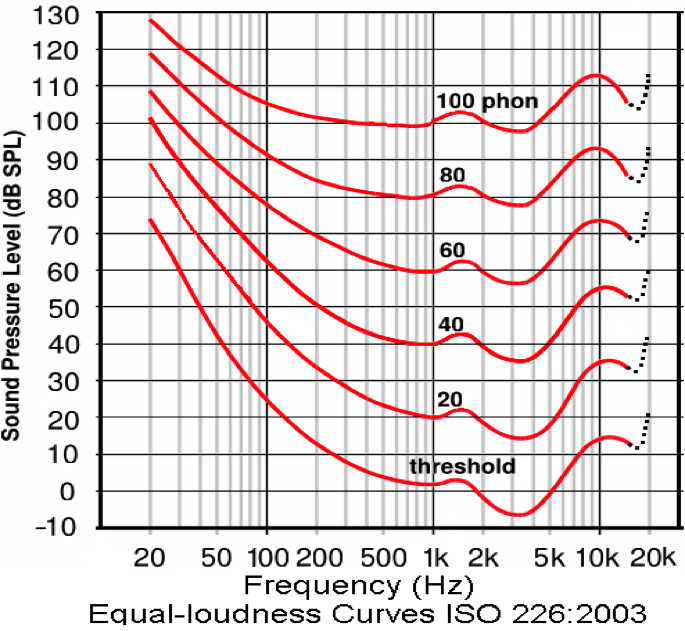
Loudness as a subjective measure is the characteristic of a sound that is primarily a psychological correlate of physical strength (amplitude) of the sound. The perception of loudness is related not only to the sound pressure level, but also to sound duration and frequency.
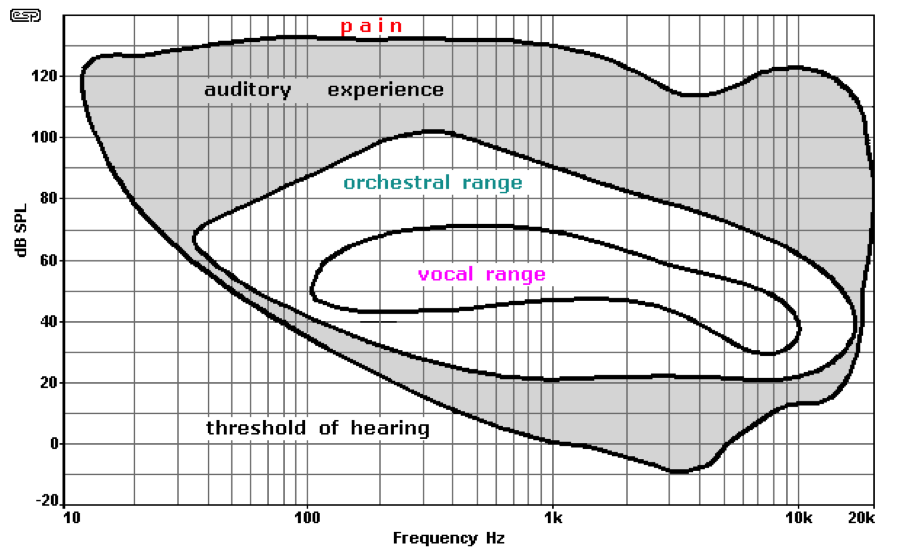
HUMAN AUDITORY SYSTEM[edit | edit source]
From the anatomical point of view the human ear consists of three parts: outer, middle and inner ear. The pinna (or auricle) and the auditory canal together form the outer ear. Its role is to bring the sound wave to the eardrum located at the end of the auditory canal. In contrast to certain species, in humans the important role of the pinna is the reflection and focusing of the incoming sound wave to the auditory canal. The auditory canal can be considered as a tube with an open end (the side adjacent to pinna) and a closed end with the eardrum (tympanum), which enhances sound in the frequency range of 2-5 kHz by its resonance.
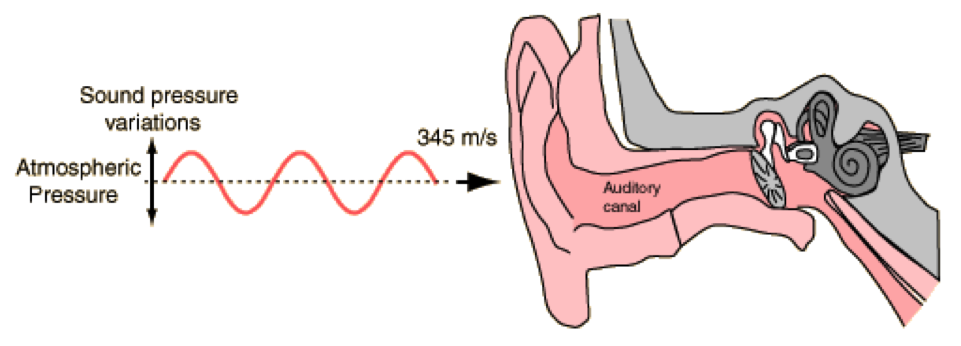
The middle ear is a cavity behind the eardrum (tympanic membrane) that, under physiological conditions, is filled by air. It includes three ear bones (or ossicles): the malleus (or hammer), incus (or anvil), and stapes (or footplate or stirrup), which are important for transmission of the vibrations of the tympanic membrane to the oval window of the inner ear. The middle ear with the three bones acts as an excellent pressure amplifier using two mechanisms: (i) area amplification due to approx. 15x larger area of tympanic membrane (eardrum) in comparison to the area of oval window and (ii) a lever-type amplification of ossicles. The proper function of the middle ear is very important for an effective transfer of sound from air to the liquid environment of the inner ear. The opening of the Eustachian tube is also within the middle ear; it is connecting the chamber of the middle ear to the back of the nasopharynx and is required for proper function of the auditory system because it equalizes the pressure between the middle ear and the surrounding atmosphere.
The cochlea - inner ear is placed in a bone and in contrast to the outer and middle ear is filled by fluids. There are three spaces within the cochlea: the scala tympani, the scala vestibuli and the scala media. The sound is transferred to the footplate of the stapes, which presses it into one of its fluid-filled ducts through the oval window of cochlea. The fluid inside this duct is moved, flowing against inner hair cells - the receptor cells of the Organ of Corti. These stimulate auditory nerve fibres, which send information through the auditory portion of the eighth cranial nerve to the brain.
Important feature of the auditory system is tonotopy (the spatial arrangement of where sounds of different frequency are processed), which begins at the cochlea. Physical characteristics of the basilar membrane cause different frequencies to reach maximum amplitudes at different positions. High frequencies are transduced at the base of the cochlea whereas low frequencies are transduced at the apex.
The inner ear includes not only the organ of hearing, but also the vestibular apparatus - a sense organ of the balance, sensitive for the effects of motion and gravity. The balance portion of the inner ear consists of three semicircular canals and the vestibule. The semicircular canals help in both dynamic and static balance. Hair cells are also receptor cells involved in balance, although the hair cells of the auditory and vestibular systems of the ear are not identical. The movement of fluid in the semi-circular canals, as well as the utricle and saccule, stimulates vestibular hair cells. Firing of vestibular hair cells stimulates the vestibular portion of the eighth cranial nerve.
PATHOLOGY[edit | edit source]
Conductive hearing loss refers to the situation when the transmission of sound to the inner ear is impaired, e.g. due to impacted ear wax (cerum), an ear infection (otitis media with effusion or OME), or calcification of the middle ear ossicles (otosclerosis). Conductive hearing loss tends to a loss of sensitivity across the entire range of frequencies, most commonly in one ear only. A so called "bone conduction test", where sound is delivered as vibration to the skull rather than as airborne sound to the ear canal, can be used to confirm a suspected conductive hearing loss.
Sensory-Neural Hearing Loss By far the most common cause of sensory neural hearing loss is damage to sensory hair cells in the cochlea. The outer hair cells in particular are very fragile, and can be damaged by exposure to excessively loud sounds, or they may simply "wear out" in old age. In more rare cases hair cells can also be damaged by certain chemicals (such as high doses of aminoglycoside antibiotics). Sensory-neural hearing loss can also be caused by damage the auditory nerve, but conditions producing such damage are relatively rare, while noise damage or age related hearing loss are very common complaints. Central hearing loss (due to damage to the central nervous system) is even rarer. Noise damage or age related hearing loss tends to produce characteristic deficits as shown in the audiograms here below. Unlike conductive hearing loss, which can often be cured, sensory-neural hearing loss is in most cases irreparable, and treatment will aim to make the best use of those auditory structures that remain intact, perhaps by boosting sensitivity through a hearing aid, or, in severe cases, by trying to bypass dead sensory hair cells with cochlear or brainstem implants.
Noise damage Because our outer and middle ear transmits frequencies near 4 kHz very efficiently, hair cells that are tuned to frequencies near 4 kHz are particularly vulnerable to noise damage. Therefore, audiograms of patients with noise damage often have characteristic 4 kHz notches.
Age-related Hearing Loss (Presbyacusis) Even if we avoid exposure to very loud noise, the ear's outer hair cells may also simply wear out as we age, leading to age related hearing loss. In this condition, high frequency outer hair cells tend to die off before low-frequency ones, possibly because the high frequency outer hair cells have to work harder if their job is to amplify acoustic vibrations on a cycle by cycle basis. Consequently, patients with age-related hearing loss often have normal sensitivity at low frequencies, but progressively poorer sensitivity for higher frequencies, as shown here:
HEARING TESTS AND AUDIOMETRY[edit | edit source]
The Rinne and Weber tests are two quick screening tests for hearing using vibrating tuning fork. In the Weber test a vibrating tuning fork is placed in the middle of the forehead and the patient is asked to report in which ear the sound is heard louder. A normal Weber test has a patient reporting the sound heard equally in both sides, while an affected patient would report louder perception in one ear. In the Rinne test is compared perception of sounds transmitted by air conduction to those transmitted by bone conduction through the mastoid. Thus, one can quickly screen for the presence of conductive hearing loss. A Rinne test should always be accompanied by a Weber test to also detect sensorineural hearing loss and thus confirm the nature of hearing loss.
Pure tone audiometry (PTA) is the basic audiometric test to find out if a hearing loss is present or not. During the test the tested person wears headphones through which pure tones at different frequencies are being presented. The intensity of the tones is gradually reduced until the hearing threshold - the point at which tones are barely audible - is found. The result is expressed in decibel (dB) scale and entered into a standard audiogram form. Audiograms are routinely measured in anechoic chambers with acoustical stimulation via headphones within the frequency range of 125 Hz – 8 kHz.
In speech audiometry is tested how much speech intelligibility at different intensity levels or in background noise is present. The test consists of a certain number of words presented to the subject and the tested person has to repeat presented words. After finishing the test a percentage of how many words were correctly repeated is calculated. Speech tests can be used for various purposes: evaluating how much intelligibility is left without using hearing instruments, predicting and evaluating the intelligibility improvement by means of hearing instruments and comparing intelligibility differences between different hearing instruments.
Tympanometry is an objective test of middle-ear function. It is an examination used to test the condition of the middle ear and mobility of the eardrum (tympanic membrane) and the conduction bones by creating variations of air pressure in the ear canal. It is not a hearing test, but rather a measure of energy transmission through the middle ear. The test should not be used to assess the sensitivity of hearing and the results of this test should always be viewed in conjunction with pure tone audiometry. In evaluating hearing loss, tympanometry permits a distinction between sensorineural and conductive hearing loss, when evaluation is not apparent via Weber and Rinne testing. Furthermore, in a primary care setting, tympanometry can be helpful in making the diagnosis of otitis media by demonstrating the presence of a middle ear effusion.
Otoacoustic emissions (OAEs) screening is based on measurement of very weak acoustical signals generated within the inner ear by a detector placed in the auditory canal of the outer ear. OAEs disappear after the inner ear has been damaged, so OAEs are often used in the laboratory and the clinic as a measure of inner ear health. There are two types of otoacoustic emissions: spontaneous otoacoustic emissions (which can occur without any external stimulation) and evoked otoacoustic emissions (which are measured in response to acoustical stimulation). Otoacoustic emissions are clinically important because they are the basis of a simple, non-invasive, test for hearing defects which can be easily applied in newborn babies and in children who are too young to cooperate in conventional hearing tests like PTA. Many countries (including the Czech Republic) now have national programs of the universal hearing screening of newborn babies.
Auditory evoked potentials can be used to trace the signal generated by a sound through the ascending auditory pathway. The evoked potential is generated in the cochlea, goes through the cochlear nerve, through the cochlear nucleus, superior olivary complex, lateral lemniscus, to the inferior colliculus in the midbrain, on to the medial geniculate body, and finally to the cortex.
Auditory evoked potentials (AEPs) are very small electrical voltage potentials originating from the brain recorded from the scalp in response to an auditory stimulus, such as different tones, speech sounds, etc. Typically are evaluated potentials originating in the brainstem (BERA) or cortex (CERA).


